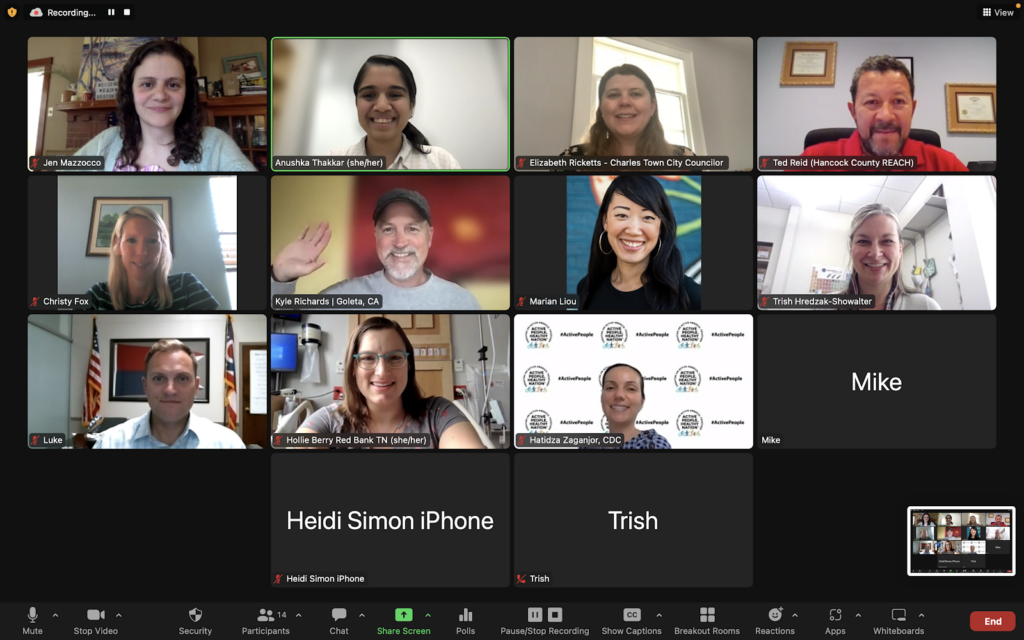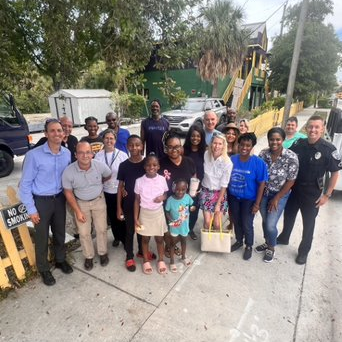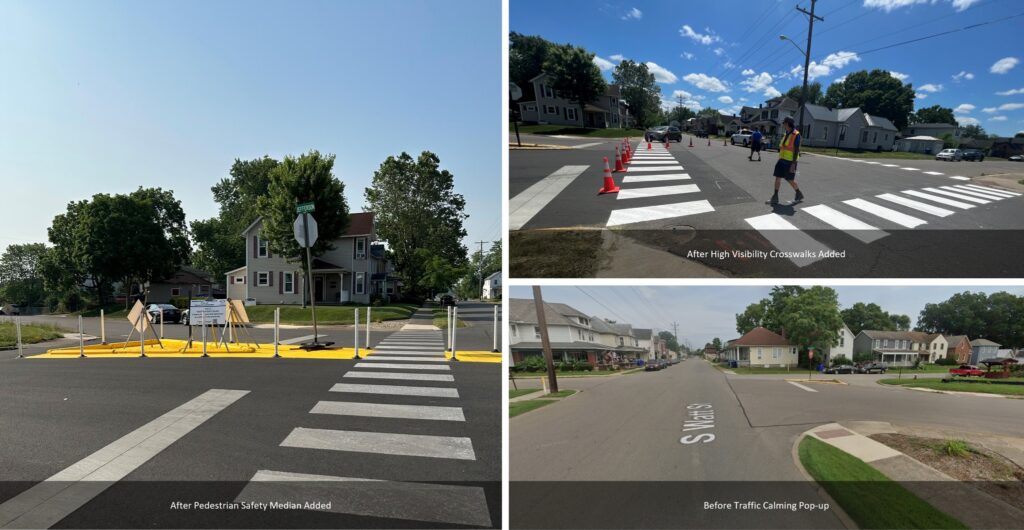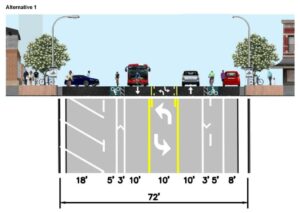We recently concluded the third year of the Active People, Healthy Nation℠ Champions Institute, where a cohort of committed elected leaders from 10 states across the country worked to implement and advocate for activity-friendly communities. Learn about what they were able to accomplish.

The Active People, Healthy Nation℠ Champions Institute—launched in 2020—is a competitive peer learning program designed to help local elected officials become effective champions for Complete Streets, downtown revitalization, demonstration projects, and other local initiatives to build activity-friendly communities. This year’s cohort included 13 leaders from 10 states across the country representing a range of small to midsize cities and counties.
Each participant chose a project to focus on over the course of the Institute. Many Champions have already achieved significant milestones from the adoption of a Complete Streets policy to implementing traffic-calming demonstration projects to securing funding for crosswalk installations.
In addition, nine of the participants adopted an Active People, Healthy Nation℠ proclamation in their local communities, further demonstrating their commitment to building healthy, active, and resilient communities: Homewood, AL; Goleta, CA; Sparta, GA; Chillicothe, OH; Dormont, PA; Red Bank, TN; Charles Town, WV; Verona, PA; and Ventura, CA.
Champions also discussed barriers and challenges they faced over the course of their projects and the strategies they used to overcome them. This was an invaluable conversation for like-minded leaders who are looking to build upon what they achieved over the course of the Institute.
As we wrapped up the session and our nine-month journey together, the virtual room was filled with lots of emotions—cheering on each other’s hard work and commitment, offering suggestions to find ways to stay connected and to follow each other’s journey—which almost felt like the last day of a wonderful school year. Smart Growth America looks forward to finding ways to work with this wave of change makers as they continue their journeys.
A brief summary of each of the Champion’s projects is below.
Institutionalizing and implementing Complete Streets policies
Councilmember Jennifer Mazzocco drafted a strong equity and implementation-focused Complete Streets policy and successfully pushed it through to pass in the Borough of Dormont, Pennsylvania. As a next step, she is working to create a Safe Mobility Commission to help implement the policy.
Councilmember Nick Sims formed and convened a Complete Streets Advisory Committee to oversee the progress and long-term implementation of the Complete Streets Ordinance in Homewood, Alabama. The committee’s immediate goals are to finalize evaluation metrics and establish priorities for local implementation.
Mayor Hollie Berry is working to create and adopt Red Bank, Tennessee’s first Complete Streets Ordinance which will be embedded in their first Transportation Master Plan. This change will enable Complete Streets considerations in every transportation-related decision going forward.
Engaging communities using walk-audits, design competitions, and quick-builds

Photo courtesy of Commissioner Christy Fox.
Commissioner Christy Fox from West Palm Beach, Florida kicked off “Adopt-a-Block”, a community-based outreach program focusing on engaging and building long-term partnerships with community members, one block at a time. She organized the first neighborhood walk in one of their low-income, inner-city neighborhoods along with conducting a Crime Prevention Through Environmental Design (CPTED) assessment to help create a roadmap for the first two blocks with specific strategies such as improving signage, sidewalks, lighting, and more.
Commissioner Terrell “Ted” Reid identified crosswalks in need of restriping to improve intersection safety in Sparta, Georgia and hosted a crosswalk design contest that allowed five winners to paint their designs on the streets, which received an overwhelming response from the community. They also installed wayfinding signage along a historical walking trail.
Mayor Luke Feeney implemented traffic calming pop-up demonstrations in three targeted areas in Chillicothe, Ohio where traffic speeds were a concern for pedestrian safety. These temporary projects were designed to test traffic calming elements (such as speed humps, traffic circles, etc.) as potential long-term solutions for these locations as well as others in the city.

Councilmember Tim Ceder is building momentum in Milton, Washington to use recently-approved traffic calming funds to build a library of temporary traffic control devices that can be deployed quickly in citizen-identified problem areas to discourage high-speed traffic.
Councilmember Dorothy Wong is working on multiple grassroots-level efforts to engage with the community and build the case for Complete Streets in Altadena, California, the sixth-largest unincorporated area of Los Angeles County. They’ve conducted several community walk audits and are in the process of planning for a community-wide Walk to School Day in the coming months.
Redesigning streets to make them more welcoming and walkable

Image source: City of Goleta
Councilmember Kyle Richards is working to implement an interim striping project in the Old Town business district of Goleta, California. This change will create a separate buffered lane for cyclists and will help make Old Town a safer, more accessible, and more desirable destination.
Mayor Friday Ellis’s project for the South 2nd Street corridor, a major artery in Monroe, Louisiana, will improve connectivity for pedestrians and cyclists traveling to downtown Monroe from a historically-disinvested part of the city. The project will provide safe pedestrian and bicycle access, improved lighting, and additional changes to beautify the corridor.
Councilmember Trish Hredzak-Showalter secured funding to improve pedestrian access by installing three crosswalks with ADA ramps and signage adjacent to a daycare, preschool, and senior center in Verona, Pennsylvania as part of a repaving process.
Councilmember Elizabeth Ricketts from Charles Town, West Virginia is leading an ongoing effort to create safe mid-block crossing opportunities along the 2-mile stretch of the Augustine Avenue Trail. These changes will make it easier for people walking to access the trail, particularly from residential and commercial parts of the city.
Councilmember Mike Johnson had success in shifting local funding priorities to projects that will improve pedestrian, biking, and ADA accessibility on Olive Street. Olive Street has a huge mix of land uses and is located in a historically-underserved community with Ventura’s highest rates of non-native English speakers as well as people with disabilities.
Smart Growth America envisions a country where no matter where you live, or who you are, you can enjoy living in a place that is healthy, prosperous, and resilient. We empower communities through technical assistance, advocacy, and thought leadership to realize our vision of livable places, healthy people, and shared prosperity. For more information visit www.smartgrowthamerica.org.
Active People, Healthy Nation℠ Initiative is a national initiative led by CDC to help 27 million Americans become more physically active by 2027. Increased physical activity can improve health, quality of life, and reduce health care costs. These improvements can help reduce the risk of at least 20 chronic diseases and conditions and provide effective treatment for many of these conditions. Other potential benefits include better school performance and improved military readiness. Building active and walkable communities can help support local economies, result in less air pollution, and create more cohesive communities. Learn more here.
The Centers for Disease Control and Prevention’s Division of Nutrition, Physical Activity and Obesity protects the health of Americans at every stage of life by encouraging regular physical activity, good nutrition, and healthy weight. Through support of state and community partners, they provide data, programs that work, and practical tools so that Americans have the best possible chance to achieve healthier lives and avoid chronic diseases.